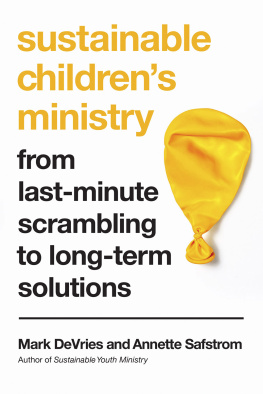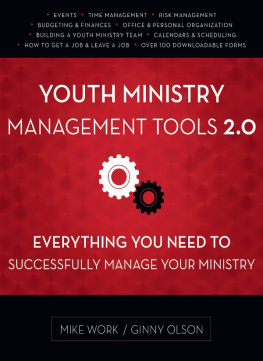1

Cracking the Code
The Anatomy of Stuckness in Youth Ministry
The declining church always assumes that the solution to youth ministry is programmatic. If only they could get a good leader! If only they could find a great curriculum! If only they could renovate a room in the building for youth meetings! They fail to recognize that the solutions to youth ministry, like the solution to decline in general, is systemic.
Thomas G. Bandy
He had done youth ministry earlier in his career, and quite successfully, he was quick to add. But over the past twenty years as a senior pastor, he had not once been able to establish a sustainable youth program in any church hed served.
There were highlights, yes: a mission trip here, a particularly effective volunteer there and even a flash of success from a memorable, short-term youth director. But the only consistent thing had been his frustration.
After an exhaustive search and the hiring of yet another youth director (the one everyone had hoped would finally turn things around), it was soon all too obvious that a snowflake in the Sahara stood a better chance than this youth pastors new and improved program.
Thats when the call came.
The despair in the pastors voice was anything but subtle. He was weary of following one new idea after another, hiring one new youth director after another. He was tired of unhappy parents of teenagers (he, in fact, was one of them), who couldnt understand why the church couldnt crack the code for building an effective youth ministry. He was tired of his youth ministry being compared (often disparagingly) to the church across the street. And he could no longer believe that this less-than-stellar ministry could all be blamed on busy kids, apathetic parents and hard-to-find volunteers. He was, in a word, stuck.
When a youth ministry isnt working, easy answers abound, the most popular of which is simply to hire away a churchs youth ministry problems. But youth directors hired to save the day often find it difficult (if not impossible) to live up to the expectations they face from the first day they walk into their offices. And as flattering as it may be initially to be branded as the answer, such an approach places on a youth worker a weight that few are called or equipped to carry.
As a result, most professional youth workers move on prematurely, some finding positions in other churches. But far too many, like one youth director we heard from recently, leave the land of youth ministry defeated and determined never to return. He wrote,
I submitted my resignation as youth pastor yesterday. I can no longer continue in youth ministry or for that matter any ministry. Im not sure if it was the overwhelming sense of failure or Gods call. I sure hope its the latter. So I am looking for a new job, not in ministry. Anyway, thanks for your time, but I dont see that it would make that much sense now.
The tragedy is that it doesnt have to be this way. Building a sustainable youth ministry is not a matter of getting lucky; there is no secret code to be cracked by the elite few. No, effective youth ministry happens when a very consistent set of factors is put in place, and it flounders when those factors are absent.
For me, the story of learning to move beyond stuck began the way most good stories beginwith a little drama.
The Nashville Drama
In 1986, I came to First Presbyterian Church in Nashville after working for eight years both in a church setting and in Young Life. Having experienced moderate success in my two previous ministries and having won my seminarys youth ministry award at graduation, I assumed that the Nashville ministry would be off and running like wildfire in no time. And I was not alone. I could smell the church leaders enthusiasm as I stepped onto the scene, the answer to their prayers.
But after five years, I had clearly become more of a prayer request than a prayer answered. Despite my seventy-hour-plus workweeks, there were few visible signs that any progress had been made. Only a fraction of the youth of our church were active in the youth program. I simply couldnt break the code.
I prayed. I went to seminars. I read books. I prayed some more. I tried a variety of models, many of which described themselves as the biblical model for youth ministry. But nothing seemed to shake the inertia. We were stuck.
With nothing working, I made the unpopular decision to cancel youth group. It was clear that the way we were doing youth group simply wasnt working. So we stopped meeting every week and focused instead on creating periodic events, specifically targeting smaller groups. The idea seemed logical to everyone; everyone, that is, except the senior pastor, the youth, the parents and the elders.
A year and a half after the change, participation was increasing almost imperceptibly. I began talking more and more about an idea called family-based youth ministry, my first shot at building a sustainable foundation for youth ministry. But dramatic change didnt come until the storm hit.
We were having an ordinary, garden-variety youth committee meetingat least I thought so. When I walked into the room, it was packed with twenty extra parents (mostly uninvited), all of whom had their opinion about what was wrong with the youth ministry, and for the next three hours, this group vented their feelings, an experience I now refer to affectionately as Rotisserie DeVries.
The next morning as I sat in my office, flipping through the want ads, fantasizing about how much easier it might be to sell cars, I got the call from Jim Robers, a busy, young businessman in our church. I certainly knew Jims lively junior-high twin boys and his uber-volunteer wife much better than I knew him. Hed been at the meeting the night before. I braced myself for another round, knowing that our church had no rule against piling on.
His first words came out of left field. That meeting last night... I realized about thirty minutes into it that you hadnt invited us there. I realized Id been set up. I dont like being set up.
I was quiet, wondering where in the world this was going.
He continued, I just want you to know that if there is anything, anything I can do for you as you try to build this program, I want to do it.
Not exactly knowing how he could help, I took him up on his offer, starting just by meeting him regularly for lunch. For the next six months, Jim, without even trying, taught me many of the core principles you will find in this book. Though he clearly didnt have time, he spent more time on lunches, phone calls and weekly committee meetings than either of us care to count.
Jim taught me what he knew: how to build an organization that works, how to build the jars of clay that can carry the treasure of the gospel. And as I ran behind Jims blocks (as this elder in the church defended me again and again), I grew in confidence. But, more important, the youth ministry fundamentally changed, setting us on course to increase dramatically both our capacity and the quality of our work with students.
It is Jims building principles that well be investigating in the coming chapters. But before we think about starting to build, well need to clear the site, removing the ideas and assumptions that most often get in the way of building on a solid foundation. We first need to identify the patterns that keep youth ministries stuck.
You Know Youre Stuck If...
Youth Ministry Architects has now assessed enough different kinds of youth ministries to recognize patterns and attitudes that keep so many youth ministries stuck. Together these attitudes make up what we have come to call the anatomy of stuckness.
The typical stuck youth ministry is built on a number of unspoken assumptions, assumptions so woven into the fabric of youth ministry that theyre barely discernible to the average youth worker. Ill put these assumptions in the form of five questions most commonly asked by stuck churches, questions that reveal fundamental misunderstandings that keep youth ministries from moving forward strategically.














